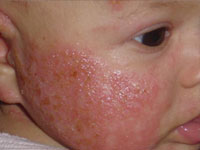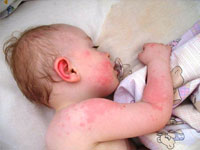Food allergies in children - a fairly common problem. An allergy in an infant may develop in response to the introduction of dust, but more often doctors have to deal with allergies in a child on a mixture. In detail about why the intolerance of the products in babies occurs - in the article.
Content
Food allergic or a state of increased sensitivity to food components, a fairly common problem in children of the first years of life. Walling in the first months of the child's life, it affects the state of immunity and in the subsequent becomes the basis for the development of senior allergic diseases.
The relevance of the problem
 First of all, we note that not all cases of food intolerance can be classified as an allergy. In children there are various metabolic diseases and toxic reactions that are similar to manifestation allergies.
First of all, we note that not all cases of food intolerance can be classified as an allergy. In children there are various metabolic diseases and toxic reactions that are similar to manifestation allergies.
The probability of developing allergies in an infant is 6-8%. Among all cases of allergies, the incubation of the intolerance of cow milk accounts for 2-4.9%, and 0.21% is allergic reactions in the ended newborn children, and 0.35% — In deep premature babies.
Causes of food allergies in children
Allergenic factor for a child can be any food. It is quite reasonable that food allergies in children is most often provoked by proteins of cow's milk, because it is the main food product at this age. Allergy in a child per mixture may also be due to the fact that most of the similar substitutes are made of milk of ruminant animals.
In the future, with the introduction of adhesive, allergen can become any food products, since the immune, and the enzymatic system of the gastrointestinal tract in small children is extremely imperfect.
Currently, the list of food allergens has more than 160 product items, but most often allergic in children cause the following products:
- Cow's milk and products made from it (97-87.5%);
- Chicken eggs and products based on them (52.5-41.9%);
- Peanuts and other nuts;
- Soy and soy products (16.2%), by the way, allergy in a child on a mixture of soy milk — Not such a rarity;
- Fish, more maritime;
- seafood;
- Wheat and wheat flour products (37.8%).
- Often the cause of allergies becomes meat of animals and birds, citrus, chocolate, honey, strawberries, strawberries.
Cow's milk — The most common cause of allergies
 Children on breastfeeding are very rarely affected by food allergies, although there are cases of intolerance to the proteins of cow milk proteins, due to the fact that during pregnancy and during the lactation, the mother abused dairy products.
Children on breastfeeding are very rarely affected by food allergies, although there are cases of intolerance to the proteins of cow milk proteins, due to the fact that during pregnancy and during the lactation, the mother abused dairy products.
Allergic in an infant child who is on artificial feeding, in most cases is associated with the milk mixture, which is used to power the kid. Most blends are made on the basis of milk cows containing more than 20 antigens, of which are most dangerous β-Lactoglobulin and casein. At the same time beta — Lactoglobulin is not destroyed even when boiling, and casein falls into a precipitate when zaking and descending, which causes the best tolerance of fermented milk products. The development of allergies on the cow's milk contributes to the early introduction of feeding in the form of a dairy cas in children who have a predisposition in atopy.
Often, in the desire to save the baby from allergies on the cow's milk, moms go to feeding soy mixtures. However, quite often the cause of atopic dermatitis and digestive disorders are precisely proteins of soy. Recently, soybean is widely used in the production of food, with the use of these products during pregnancy, the future mother, herself is not knowing, it is often obscured by the kid to suffering.
Fish fish — Ros
The presence of allergies on the chicken egg protein automatically implies the intolerance to the eggs of another bird, and often chicken meat.
Frequent cause of exacerbation of allergies in children of the first year of life becomes fish, so it is recommended to exclude their nutrition of children under 12 months. With age, sensitization to fish proteins is reduced, sometimes disappears at all and then you can try to enter fish products in the Child menu. Seafood, such as shrimps, lobsters, scallops, oysters, mussels at all should be present at the children's table up to 3 years. It should be treated with caution to cereals, allergic to proteins of wheat, rye, less often buckwheat, oats and rice is not so rare.









